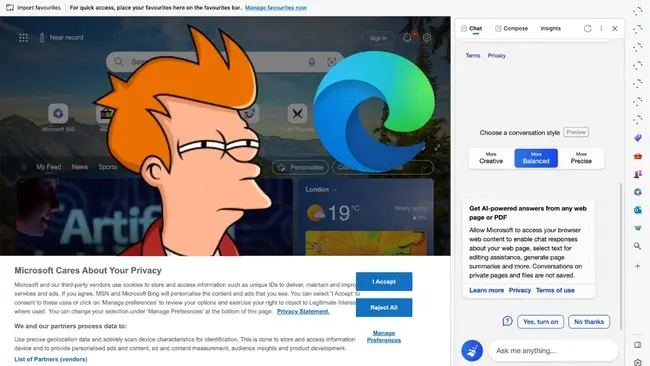From a forgotten browser to a leader in AI search, Microsoft Edge is the search industry's phoenix from the ashes. But, as AI features mount, things are getting confusing.
Since the launch of OpenAI’s ChatGPT last year, Microsoft has been investing heavily in making Edge the best browsing experience in the AI market.
It began with an $11 billion partnership with OpenAI, which promised a slew of new AI tools for software developers and AI enthusiasts.
Then came Bing Chat, Microsoft’s own AI chat interface powered by ChatGPT, which quickly made its way onto Edge and became the browser’s standout feature.
The AI chat tool now sits in Edge’s new sidebar, appearing as a big Bing button at the top left of Edge’s home screen along with a bunch of other Microsoft services.
Next to it is an array of other new tools added to this sidebar in the Discover section, all of which provide nieces AI features for search games, Office and Outlook.
Slide a little too close to this Bing chat section, however, and the AI chat interface unexpectedly takes over half of the screen, covering the item being searched.
Disabling the sidebar in settings is an option, but it comes at the cost of losing much of Bing's functionality, as Microsoft integrated the Bing button into the sidebar.
But this is just one part of a much larger problem. A problem rooted in Microsoft’s rush to make Edge the leading AI browser and the emblem of how the AI arms race is rushing innovation.

Piece by piece
For anyone using Edge on a daily basis, the platform can look very different on one day than it does on another.
That’s because Microsoft has rolled out features gradually, adding, removing and changing features piece by piece rather than waiting until the whole puzzle is complete.
While this approach allows Microsoft to gain feedback on features being rolled out regularly, it can make it difficult for IT administrators and managed service providers to use the browser, as they cater to mixtures of users who may be on various versions of Windows and in environments with managed or unmanaged updates.
Microsoft sees anyone not on a domain or Azure Active Directory as being unmanaged, and therefore those workstations may get changes and features at a different period than workstations that are seen as managed.
This leads to members of the same team working on different versions of Edge at a given time, breaking up teams by granting them access to different tools, software and services.
Taking the Edge off
Microsoft does provide a significant number of controls for Edge, particularly for those seeking group policy management. For instance, there are numerous group policies to manage the sidebar, offering control over its functionalities.
Companies have the option to block the Edge’s sidebar or specific extensions from appearing within it. Presently, the sidebar includes features such as Search, Discover, Tools, Games, Office, and Outlook, with further options in the pipeline.
There is also Group Policy setting has been introduced to disable the chat icon. To access this setting, users can download the ADMX Templates for Windows 11 October 2021 Update [21H2] from the Official Microsoft Download Center, and copy the files from C:\Windows\PolicyDefinitions on a Windows 11 computer to your central policy store.
Regardless, the fact that these settings are not easily accessible means that Edge is still a long way from overtaking Google and becoming the world’s default browser.
Microsoft should take a leaf from Firefox's book and introduce a version of Edge with an Extended Support Release called Firefox ESR, which delivers a long-term stable version of the browser with fewer changes and disruptions.
Edge’s AI capabilities may be impressive, but if its integration is so convoluted that it reduces productivity rather than increases it, then it defeats the object of the technology.
Like Internet Explorer, Edge is becoming more integrated with Microsoft 365 instead of Windows. Its future remains uncertain, but excessive integration is what ultimately led to the downfall of Internet Explorer.







Comments ( 0 )